I get up at 5:15 when the alarm goes off. I’m not usually ready to awaken yet. It’s still dark. There’s no water from the tap yet at this time of the day, so I use water from my storage bottles to wash my face and brush my teeth. Sometimes I heat a little bit of water in my electric teapot and splash warm water on my face – a treat! (For those of you who don’t know – we have no hot water from the tap.) I make sure I have everything for the day in town – take the sheets off the bed if I’m taking laundry, umbrella, money, paperwork, books to return to the PC office, something to read on the bus, flash drive, sometimes my camera, etc. A little before 6:00 I start watching out my window for Afakasi to start the bus.
Afakasi lives in the family compound next to us and drives a fire-engine-red red bus to Apia Monday through Saturday. There are no Sunday buses. Even though going on Afakasi’s bus is the long way (instead of taking the cross-island bus which I could catch on the main road and which would take me to Apia in a little over an hour, instead of two hours), I much prefer it for several reasons. First of all, it’s so convenient. I can walk out my front door and get on the bus with no waiting and get a good seat. The seats are comfortable, “normal” bus seats compared to the wooden benches on the other buses. I don’t have to carry my bags to, or especially from, the main road (about a half mile walk). And lastly, many of the passengers on the bus are people from Poutasi or neighboring villages who I know.
When he starts the bus I walk over, and because I’m the first on the bus, I always get the seat I want, which is the left front seat by the window. It’s cooler and more comfortable by the window; there’s more leg room in the front and therefore room for my bags in front of my feet; and, because I’m usually one of the first off of the bus, it’s much easier to get off. I usually have a number of people sit beside me during the ride to Apia. Someone will sit there – say a middle-aged man for example. When an older man gets on the bus, he’ll give up the seat to him and move back. If an elderly woman then gets on the bus, he’ll give up the seat to her and move back. If there are no seats left at that point, someone younger will give up their seat to the elderly man and so on. By the time we’ve picked up all of the passengers there are people standing in the aisles, sometimes all the way to the front door, and sitting on each another’s laps.
I’ve been riding the bus from Poutasi to Apia and back for six months now at least once a week, and I still enjoy the ride. Sometimes I nap or read, but more often than not I just look out the window, relax, daydream, and enjoy the scenery which is stunningly beautiful. I also enjoy watching the people as we drive through villages along the way.
In the early morning it’s cool – yesterday I actually used an ‘ie (a piece of cloth which wraps around as a long skirt) from my laundry tote as a shawl as it was really chilly (at least to me in this tropical climate – it was probably only about 70!). We drive into the sunrise with shades of pink and orange and blue blending together on the horizon.
There are usually about a dozen or so people from Poutasi who get on the bus and then we stop at every village along the way, and in between, until we get to Salani. To catch a ride on a Samoan bus you don’t need to wait at a bus stop. You just wait on the road in front of your house and the bus will stop for you. Sometimes Kasi stops for someone to get on, and then stops again 100 feet down the road.
At Salani we cease traveling along the southeastern coast and turn to climb the road to Le Mafa Pass (which is redundant, since mafa means pass, but that’s what it’s called on the maps and signs). There are magnificent views all along the way, especially on this stretch of road. Although the pass is only about 1,000 feet in elevation, and the tallest surrounding mountains are only a little over 3,000 feet, the view from the pass is amazing. There is a steep descent to the river valley below and you can see all the way to the ocean, about seven miles away. The valley and the surrounding hillsides are lush with tropical vegetation – tree ferns twenty feet tall, coconut palms, towering banyan trees snaking roots to the ground, teak trees with leaves the size of placemats, and an under story of vines and ferns. In the sunshine everything is vibrantly green with a brilliant blue sky and white puffy clouds. Sometimes early in the morning the clouds are below us and wind their way through the valley below as if looking for a way out.
When the bus climbs up the mountain it creaks and groans and Kasi downshifts and urges it along. Let’s say the average Samoan weighs 200 lbs. With about 70 people (on a bus with 29 seats) this is seven tons of people! Yes, there are a few children on the bus as well, but there are also many Samoans who weigh well over 200 lbs, and there are bags and baskets of produce to be sold at the market in Apia.
There are a few homes along the mountain road, but no villages. After we make the descent from the pass we begin to drive through villages again, all the way to Apia. We pass Falefa falls and drive beside the roaring Falefa river. Now we’re on the north side of the island with waves crashing close to shore with the white foam of the breakers sometimes spraying onto the rocks along the side of the road.
Naturally it’s usually about this time that I’ve been lulled into getting sleepy when we’re only about a half hour from Apia. Sometimes I give in and nap a little. Then it’s time to tell Kasi, “Taofi i le Ofisa Pisikoa fa’amolemole,” and he stops on the street in front of the Peace Corps office. I’m in Apia for the day and it’s about 8:00 am.
After a day of shopping, email, other Apia errands, and lunch in a restaurant – a real extravagance – I head home. Although the bus doesn’t leave to head back to Poutasi until 4:30, I try to get there between 3:30 and 4:00 to get a good seat. The last time I didn’t get there early enough and I sat about four seats back in the bus wedged between a very fat man sitting by the window on my right with a snotty kid on his lap, and another very fat man standing in the aisle next to me who was smoking (yes, people smoke on Samoan buses). You might wonder why no one gave up his/her seat to me. Well, actually they did. The bus was totally full already and someone gave up that seat to me. But the good news was, that meant I’m just one of the villagers and no one felt they had to give me the best seat on the bus!
But assuming I get there early, I usually read while I’m waiting for the bus to leave. It’s very hot sitting there in the bus waiting. By the time the bus leaves I’m usually hot and sweaty all over down to the roots of my hair. Got to keep that seat though!
Yesterday Mataomanu sat by me with her four-year old grandson Sam on her lap. She lives in Poutasi, is the president of the Women’s Committee in the village, and a 3rd grade teacher at the primary school. She’s a very pretty, plump older woman and I like her very much. She wears wire-rimmed glasses and has a merry look about her. If she was fair of skin and wearing red velvet instead of tropical prints, she would look like Mrs. Santa Claus. Her husband is Meleisea, one of the high chiefs of the village, and he reminds me of my dad. I’ve been trying to figure out why – he doesn’t look anything like him, except that he’s balding – but now that I think about it, I think I do know why. He always has a smile for everyone. But I digress . . .
So we begin the journey home. A couple of miles out of town we stop at Pacific Express, a small general store, where most people get off the bus for drinks, snacks, and a few last minute groceries. Then it finally begins to cool off when we get going again with the wind blowing in the open window. The CD on the bus is playing loud Samoan music, and this same CD will play over and over again all the way home. The air is wet and the colors are intense from the rain shower just past. The sea and the coconut palms rush by on my left; the forest is a vivid green blur on my right, with houses, churches, and small stores interspersed as we pass through small villages. We drive by men trimming the bushes with machetes. Teenagers are playing volleyball in the mud. Waves are crashing on the reef off-shore. We pass a procession of about 20 people walking down the road, led by a priest carrying upright in front of him a three-foot high cross – everyone is dressed in white. Two young boys run alongside, racing the bus as it goes by. Multicolored laundry is lying on the rocks in front of the houses to dry. Bananas, cocoa, taro, mango, breadfruit and papayas grow everywhere. Young men going to Apia crowd into the back of an old blue pickup truck; others hang out in front of the tiny village stores. Young girls walk down the road holding hands. Old women pull weeds from between the small rocks in front of their houses. There are ever-present flowers of pink, red, yellow, orange, and white. Dogs, chickens, and sometimes pigs, scurry to get out of the way of the bus. Women are washing cooking pots at the water tap in the front yard. A boy on a bike wobbles carrying coconut frond baskets filled with garden produce on each side of the handle bars. Children are helping to clean up the yard picking up the large leaves and placing them in similar baskets. I smell the smoke from the cooking fires. There are people everywhere. Families are gathering at the end of the day.
As we go by Falefa falls, leaving the villages, and beginning to climb up to the pass, mud hens dart across the road every now and then. Wispy clouds brush the mountaintops. Three-foot high stacks of coconuts sit by the side of the road to be picked up by the buyer. Cattle graze in the valley below between the coconut palms. We pass Mafa with its spectacular view all the way to the ocean, more waterfalls, and roadside stands selling produce. Now we’re back to the villages on the south side of the island. There is a mother sitting on her front door step nursing her baby. Fala is drying in front yards to weave into mats. Naked little boys are running across the grass. A woman stands in front of her house with her long black hair shiny-wet from the shower with an bright pink and blue ‘ie wrapped around her sarong-style. There is the still, clear water of the mangrove lagoon in Vaovai. Horses are tethered at the side of the road eating grass. We slow down for the bumpy drive into Poutasi. Children are splashing and playing in the sea. The sun is sinking into the ocean in a blaze of red and gold. It’s 6:30 pm. Home sweet home.
Subscribe to:
Post Comments (Atom)
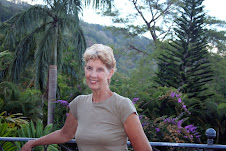
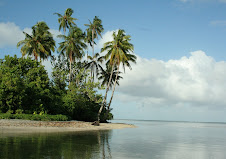
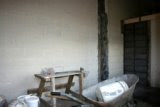
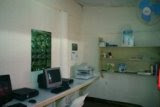
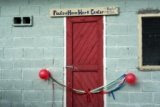
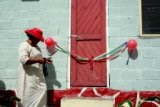
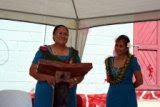
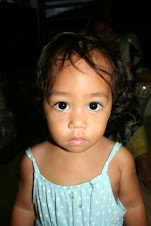
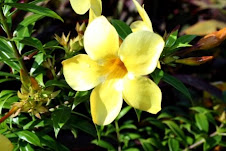
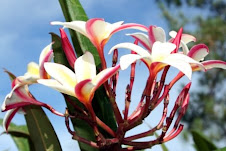
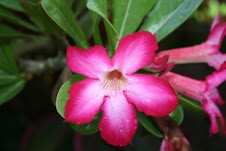

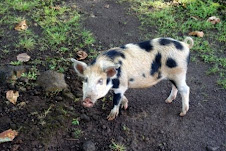

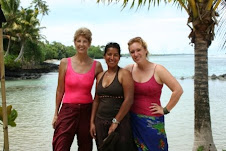

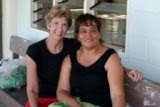

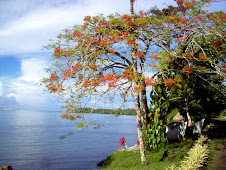
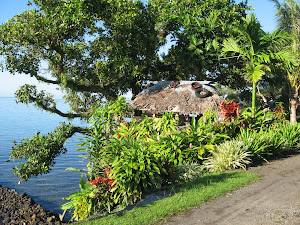
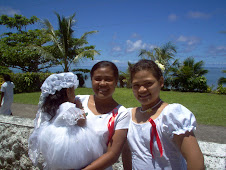
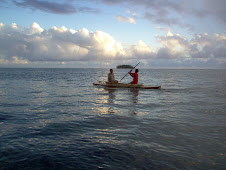

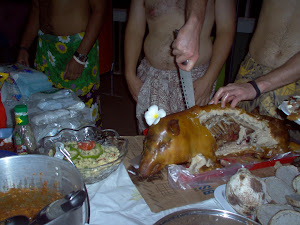
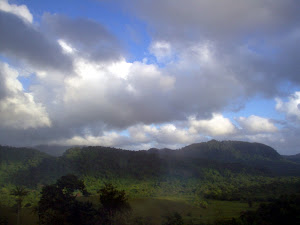
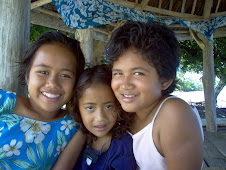.jpg)
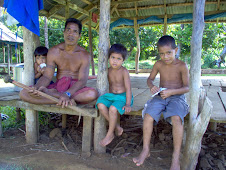



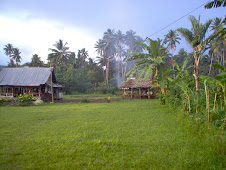



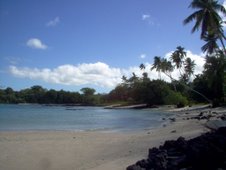
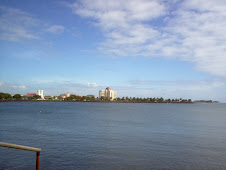

No comments:
Post a Comment